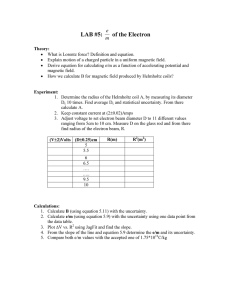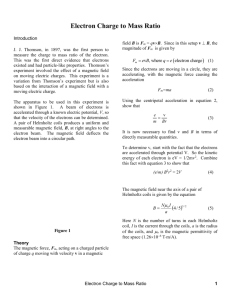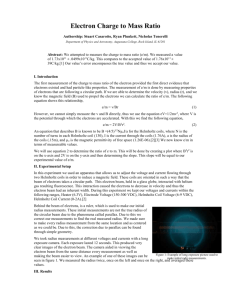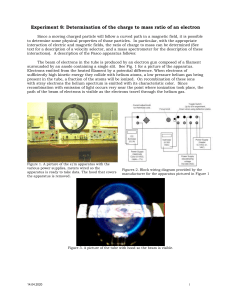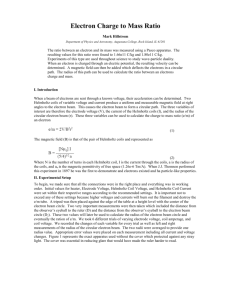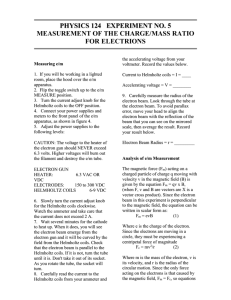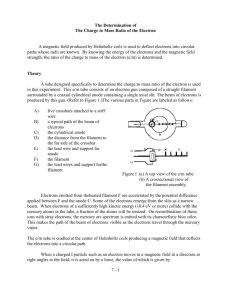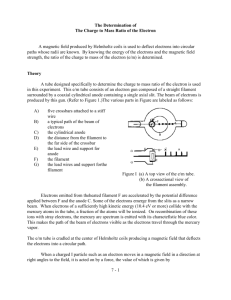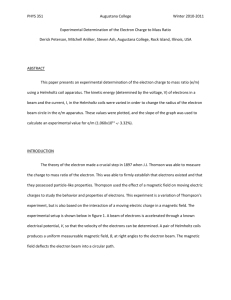220 11-1 EXPERIMENT 11
advertisement
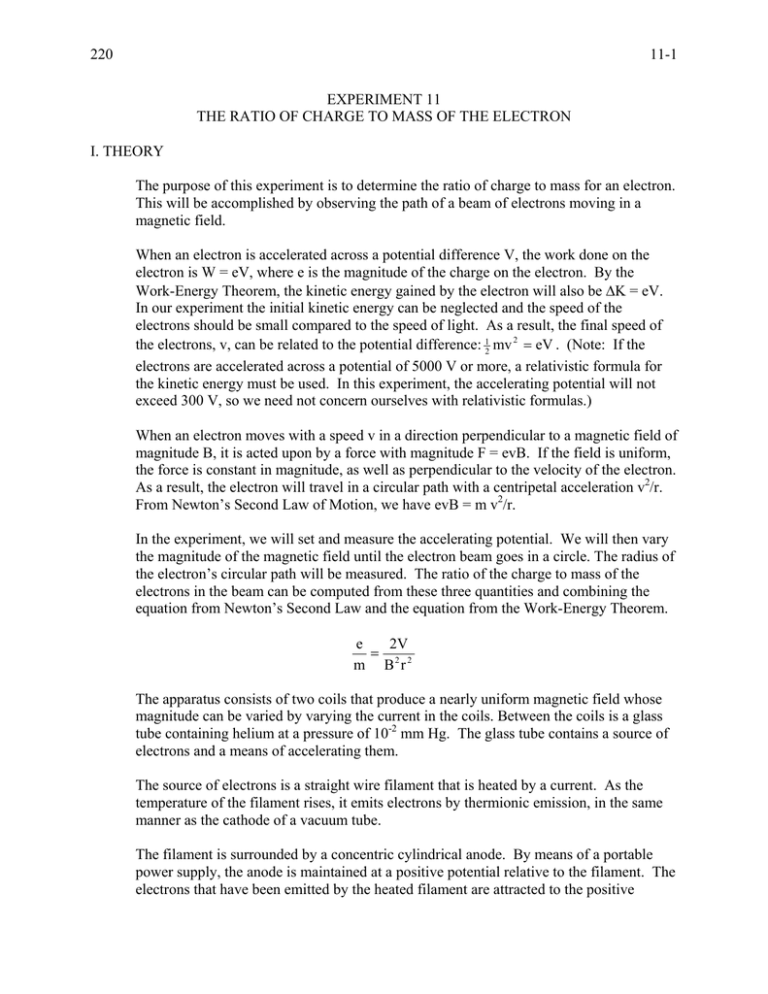
220 11-1 EXPERIMENT 11 THE RATIO OF CHARGE TO MASS OF THE ELECTRON I. THEORY The purpose of this experiment is to determine the ratio of charge to mass for an electron. This will be accomplished by observing the path of a beam of electrons moving in a magnetic field. When an electron is accelerated across a potential difference V, the work done on the electron is W = eV, where e is the magnitude of the charge on the electron. By the Work-Energy Theorem, the kinetic energy gained by the electron will also be ΔK = eV. In our experiment the initial kinetic energy can be neglected and the speed of the electrons should be small compared to the speed of light. As a result, the final speed of the electrons, v, can be related to the potential difference: 12 mv 2 = eV . (Note: If the electrons are accelerated across a potential of 5000 V or more, a relativistic formula for the kinetic energy must be used. In this experiment, the accelerating potential will not exceed 300 V, so we need not concern ourselves with relativistic formulas.) When an electron moves with a speed v in a direction perpendicular to a magnetic field of magnitude B, it is acted upon by a force with magnitude F = evB. If the field is uniform, the force is constant in magnitude, as well as perpendicular to the velocity of the electron. As a result, the electron will travel in a circular path with a centripetal acceleration v2/r. From Newton’s Second Law of Motion, we have evB = m v2/r. In the experiment, we will set and measure the accelerating potential. We will then vary the magnitude of the magnetic field until the electron beam goes in a circle. The radius of the electron’s circular path will be measured. The ratio of the charge to mass of the electrons in the beam can be computed from these three quantities and combining the equation from Newton’s Second Law and the equation from the Work-Energy Theorem. e 2V = 2 2 m B r The apparatus consists of two coils that produce a nearly uniform magnetic field whose magnitude can be varied by varying the current in the coils. Between the coils is a glass tube containing helium at a pressure of 10-2 mm Hg. The glass tube contains a source of electrons and a means of accelerating them. The source of electrons is a straight wire filament that is heated by a current. As the temperature of the filament rises, it emits electrons by thermionic emission, in the same manner as the cathode of a vacuum tube. The filament is surrounded by a concentric cylindrical anode. By means of a portable power supply, the anode is maintained at a positive potential relative to the filament. The electrons that have been emitted by the heated filament are attracted to the positive 220 11-2 anode. A slit is cut into the anode, parallel to its length. A narrow beam of electrons passes through the slit and moves in a circular arc (because of the magnetic field) inside the glass tube. A small amount of helium vapor inside the glass tube permits the experimenter to see the electron path, because the helium atoms emit a faint glow as they are energized by the colliding electrons. Because of collisions, the electrons in the beam will have a range of velocities up to a definite maximum. The maximum velocity applies only to those electrons that have escaped collisions. Therefore, the curved path has a sharp outer boundary traversed by electrons that have escaped collision. The previous equations apply only to these electrons, since the electrons that do undergo a collision will have a loss of kinetic energy. A mirrored scale is attached to the back of the rear Helmholtz coil. It is illuminated by lights that light automatically when the filament current is turned on. By lining the electron beam up with its image in the mirrored scale, you can measure the radius of the beam path without parallax error. The magnetic field is produced by a pair of Helmholtz coils, two identical circular coils of radius R, each mounted perpendicular to an axis through their centers, and located a distance R apart. This arrangement gives a rather uniform magnetic field in the region between the coils. The magnitude of the magnetic field at a point located a distance x along the axis from the center of a single circular coil of N turns, each of radius R and carrying a current I, is given by B1 = μ0 N I R 2 ( 2 R2 + x2 ) 3 2 The permeability of free space, μ0, has a numerical value of 1.257 x 10-6 Tm/A. At the point midway between the two Helmholtz coils, x has a value of R/2. The magnitude of the field produced by both coils at the midpoint is B= 8 μ0 N I (125) 1 2 R The manufacturer states that the magnetic field at the center of the coils can be written as B = (7.80 x 10-4 T/A) I where I is the current in the coils. 220 11-3 II. LABORATORY PROCEDURE 1. Use a meter stick and caliper jaws to measure the inside diameter and outside diameter of the Helmholtz coils. 2. Look at the diagrams of the e/m apparatus in section IV. Flip the toggle switch up to the e/m MEASURE position. Turn the adjust knob for the Helmholtz coils to the OFF position. Connect the power supplies to the front panel of the e/m apparatus as shown in the diagram. Use the 0 to 500V range on the High Voltage Power Supply. The voltage control knobs on both power supplies should be in the zero (full counterclockwise) position. The current control knob on the Low Voltage Power Supply should be in the maximum (full clockwise) position. The voltage to the filament should be set to 5 VAC. Have your instructor check your connections before proceeding. 3. Plug in and turn on the two power supplies. Check that the High Voltage Power Supply is reading on the 500-volt scale. Adjust the power supplies to the following levels: Electrodes: 250 VDC Helmholtz Coils: 7 VDC. All voltages and currents will be read from the displays on the fronts of the power supplies. 4. Slowly turn the current adjust knob for the Helmholtz coils clockwise until the current reading on the Low Voltage Power Supply is about 1.5 A. The current reading on the Low Voltage Power Supply should never exceed 2 A. 5. Wait several minutes for the cathode to heat up. When it does, you will see the electron beam emerge from the slit. It will be curved by the field from the Helmholtz coils. Check that the electron beam is parallel to the Helmholtz coils. If it is not, turn the tube until it is. Don’t take the tube out of its socket; as you rotate the tube, the socket will turn. 6. Make a table with one column for each of the following quantities: Accelerating Potential (V), Coil Current (A), Position of Left Side of Beam (cm), Position of Right Side of Beam (cm), and Beam Radius (cm). 7. You should now have an accelerating potential of about 250 V and a current in the Helmholtz coils of about 1.5 A. In your table, record the accelerating potential and current as displayed on the power supplies. You will also record the position of the left and right sides of the circular path of the electron beam. 8. Carefully measure the position of the left side of the electron beam. Look through the tube at the electron beam. To avoid parallax errors, move your head to align the electron beam with the reflection of the beam that you can see in the mirrored scale. Record the position as read from the mirrored scale. Repeat this process for the right side of the beam. The average of these two readings is the radius of the electron beam. 9. Estimate the uncertainty in the readings for each side of the beam. This value will also be the uncertainty in the radius of the electron’s path. 220 11-4 10. Repeat steps 7 and 8 for the same accelerating potential and currents of approximately 1.6 A, 1.7 A, and 1.8 A. 11. Change the accelerating potential to about 300 V and repeat the above measurements for the same currents used before. 12. You should now have a table with 8 sets of data. Turn the current control knob for the Helmholtz coils and all voltage control knobs to the zero (full counterclockwise) position. Turn off the power supplies. III. CALCULATIONS 1. Calculate the average radius of the Helmholtz coils, in meters. 2. Use the manufacturer’s expression for the magnetic field to find the number of turns in each coil of the Helmholtz coils. 3. Show that the equation evB = m v2/r. e 2V = 2 2 can be obtained from the equations m B r 1 2 mv 2 = eV and 4. Make a table containing the following quantities: current, magnitude of the magnetic field of the coils, accelerating potential, radius of path, and ratio of charge to mass. Include units for all columns. Show the calculations in one of the eight cases. Although all calculations must, of course, be carried out in SI units, the table is easier to read if results are presented in units that do not require scientific notation; for example, magnetic fields could be in μT. 5. Are the calculated values of e/m approximately constant? 6. Find the average of the eight experimental values of e/m. Calculate the accepted value of this ratio from the accepted values of e and m as listed in your textbook. Find the percent error in your experimental value for e/m. 7. Assume that the uncertainty in the current is 0.02 A and that the uncertainty in the accelerating potential is 2 V. Using these values and your estimate of the uncertainty in the radius of the electron’s path, calculate the possible relative error in your value of e/m. Compare this to your percent error and discuss the meaning of these results. 8. What source of systematic error did we ignore during the performance of this experiment? Discuss how ignoring this error might affect the results of the experiment. 220 11-5 IV. DIAGRAMS + Low Voltage Power Supply (Helmholtz Coils 6-9 VDC) + (Accelerating Voltage 150-300 VDC) (Filament voltage 5 VAC) High Voltage Power Supply
